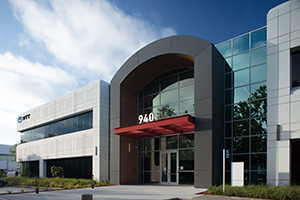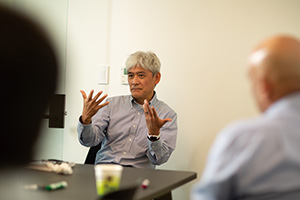 |
|
|
|
|
|
Feature Articles: NTT Research: Open Collaboration to Upgrade Reality Vol. 20, No. 1, pp. 10–12, Jan. 2022. https://doi.org/10.53829/ntr202201fa1 Opening Up about Our Collaboration StrategyAbstractThere are several means of conducting scientific research. Corporations have traditionally adopted a proprietary approach. The academic world, by contrast, conducts research in a more open and collaborative manner. This article compares these two approaches in the context of basic and applied research; explains why NTT Research, a private company, has adopted an Open Lab model; and reviews how this is working out in practice. Keywords: Open Lab, research strategy, research community 1. Proprietary vs. open modelsUntil a few decades ago, corporations typically conducted research using internal resources alone. One classic example was Bell Telephone Laboratories. Originating from engineering departments within the American Telephone & Telegraph (AT&T) and Western Electric companies, and now known as Nokia Bell Labs, this famous research organization was responsible for many breakthrough technologies, including the electronic transistor. These results, including thousands of patents, were the outcome of basic and applied physics research conducted by Bell Labs’ employees. Another example on a smaller scale is that of a former Bell Labs engineer, Chester Carlson, who patented a dry photocopy technique known as Xerography that he developed in his laboratory. Each technology, the transistor and Xerography, grew into very big businesses in the 20th century. However, many companies in the U.S. are now focusing on applied research for their products or services, such as autonomous driving, artificial intelligence based on deep neural networking, etc., rather than on basic research. Basic research has tended to be the domain of universities, not corporations, and this remains the case today. This kind of research has the potential for various future products and services, but these beneficial outcomes require very long lead times and the assumption of many types of risks. In addition to established laboratories in Japan, NTT founded NTT Research in the U.S. with the transformational vision of “Upgrade Reality.” NTT believes exploring basic research is also a means to create brand-new business value in the future. In theory, by hiring the right mix of scientists, NTT Research could try to gain a monopoly on any new knowledge acquired in this pursuit, along with the rights of invention. However, the founders of NTT Research chose another path. We realized that many of the challenges facing our current and future generations are extremely complex and closely intertwined. For example, one of the goals of medical care is to enable patients to recover from illness and maintain their health more easily. Everyone has a different constitution, so we believe it is necessary to provide precise medical care suited to the individual. When we explore precise medical care, we need not only medical and biological knowledge but knowledge related to drug discovery, sensing, big data analytics, treatment materials, etc. To achieve precise medical care, we believe we need to improve upon the accuracy of these technologies. To gather as much insight, experience, and wisdom as possible, as well as to manage our risk in precision medical care and other research areas, we decided that an Open Lab strategy was the better way to go. This Open Lab approach is more akin to academic and government-sponsored research, rather than corporate research, which on the whole aims for short-term product development. Research universities pursue scientific discovery in the open, with results shared and evaluated by peers. Foundational knowledge is often the common goal. Government-directed research may have more specific goals, but it is also a collective effort for social benefit. The U.S. Defense Advanced Research Project Agency (DARPA), famously responsible for creating the Internet by collaborating with several universities, is a case in point. The NTT Research executive team and board have taken the lead in establishing the vision “Upgrade Reality,” and setting goals such as a cardiovascular bio digital twin and a quantum computing system based on optical technologies. Our vision and goals are connected to resolving parts of social problems, for instance: precise medical care through the bio digital twin or drug discovery through a new kind of quantum computing. Because our high aspirations are beyond the reach of any single company, we have adopted an Open Lab strategy that faces outward, predominantly through joint research projects with other worldwide research organizations. We contribute our new knowledge, results, and findings in the public as papers or as joint patents with collaborators. We also see ourselves as a venue for discussion, seeking various viewpoints to expand upon the ideas of any individual researcher.
2. Open-source and NTT Research operationsIn certain ways, our method resembles that of open-source software development. In that model, an individual or small community first approaches a coding project with a vision and goal. When more developers and users realize the value of the initiative, the community expands, attracting developers of not only core software but also applications. The knowledge and ideas proposed by community members improves the code, which in turn increases its value. The Coherent Ising Machine (CIM) research group within our Physics and Informatics Laboratories (PHI Lab) has a comparable record. Starting with just several internal employees, within our first year the CIM group gained eight joint research partners, covering theoretical and hardware research of optical-based quantum computers. In our second year, this has grown to 13 organizations and over 60 members, including collaborators. We are now achieving new breakthroughs as we gain employees and collaborators, including scientists who are researching CIM applications, such as compressed sensing, drug discovery, and artificial/biological brain science. Like the PHI Lab, our Medical and Informatics Laboratories (MEI Lab) has a clear and visionary lead product—the aforementioned bio digital twin, a virtual replica of individuals in cyberspace. In the initial phase, we are focused on the cardiovascular system. The MEI Lab is also engaged in research on implantable electrodes and remote sensing that can capture many types of vital information from the actual human body. Like the PHI Lab, the MEI Lab can subdivide its research, with collaborators taking on parts of the agenda. The National Cerebral and Cardiovascular Center in Japan and the Technical University of Munich in Germany, for instance, have become key partners. Measured in terms of contributions to leading academic conferences, our Cryptography and Information Security Laboratories (CIS Lab) has become a world leader in its field. While the CIS Lab has established several joint research agreements, its members also collaborate with peers on a less formal, topical basis. The cryptography team’s research is more academic and theoretical, whereas the blockchain team’s work is more applied, with implications in law, privacy, and other practical concerns. Theoretical research within cryptography is deepened by discussions between researchers who have the same interest in a target topic. It resembles the kind of small community that initiates an open-source project. Members of an open-source community might write code and documents as their goal. Our CIS Lab researchers write scientific papers. Across all three labs, we might adjust our strategy if some topics shift from basic research into product development. Regarding basic research, where discoveries should become public assets, the Open Lab strategy is a sound method.
3. Open Lab requirementsTo succeed, an Open Lab strategy needs to meet several requirements. Funding is key, as it can clearly accelerate research activity. However, without a clear vision, strong leadership, and an effective team, funds are likely to be inefficiently distributed. Of all requirements, vision is the most important. About 40 excellent researchers have gathered around our “Upgrade Reality” vision over the past two years. We hope to improve upon today’s “Reality,” addressing social and industrial problems that face the current and next generations. With a clear vision, the direction of research proceeds in the right manner. However, this is not necessarily without detours, which are often associated with trial and error. Basic research, especially involving multiple laboratories, contains a natural element of surprise. Therefore, we need to allow for some flexibility as well. Because basic research involves unknown facts and brand-new technology, it also carries risk. By subdividing and distributing tasks, the Open Lab strategy helps to manage that risk and increase the likelihood of success. |
|











